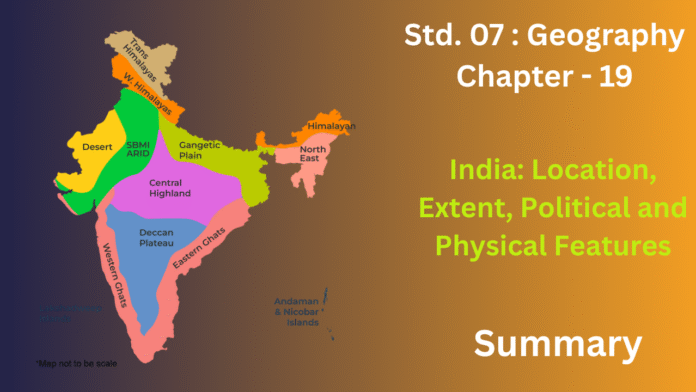India: A Geographic Overview
This chapter introduces us to India, a truly fascinating country with a rich blend of geography and culture. We learn about its position on the globe, how vast it is, and the incredible variety of its landscapes, all of which have shaped its history and people.
The chapter pinpoints its precise latitude and longitude, which helps us understand its tropical and subtropical climate. India’s peninsular shape, jutting into the Indian Ocean, is also highlighted as a significant geographical feature. This gives it a long coastline and has historically influenced its trade and cultural interactions with other parts of the world.
Next, we get a sense of India’s sheer size. The chapter details these administrative divisions, helping us understand the political map of India. Knowing these divisions is key because each region often has its own unique characteristics, from its language to its local traditions.
Perhaps the most exciting part of the chapter is the dive into India’s physical features. It’s like a mini-continent in itself! We explore the majestic Himalayas in the north, which are the highest mountain ranges in the world. These mountains act as a natural barrier, influencing climate and providing sources for mighty rivers. Below the Himalayas lies the vast Northern Plains, formed by the fertile alluvial deposits of rivers like the Ganga, Brahmaputra, and Indus. This region is incredibly important for agriculture, supporting a huge population.
This area is rich in mineral resources. Finally, the chapter covers the coastal plains that fringe the peninsula, offering fertile land and important port cities. Don’t forget the island groups too – the Lakshadweep in the Arabian Sea and the Andaman & Nicobar Islands in the Bay of Bengal, each with their own distinct features.
In essence, this chapter paints a comprehensive picture of India, showing us how its location, vastness, and diverse physical landscapes have all come together to create the unique country we know today. It’s a foundational chapter that sets the stage for understanding more complex geographical concepts about India later on.
Exercises
A. Fill in the blanks
1. There are ________ union territories in India.
Ans : seven
2. The ___________divides India into two halves.
Ans : Tropic of Cancer
3. The Himalayas literally means __________.
Ans : abode of snow
4. The Lakshadweep Islands have been formed by the growth of _______.
Ans : corals
B. Identify who I am
- A river that divides the Peninsular Plateau of India into the Malwa and the Deccan plateaux : Narmada.
- A vast sandy low-lying plain in north-west Rajasthan : The Thar Desert.
- Barren Island is the only volcanically active island of India.
- The longest river of south India : Godavari.
C. Distinguish between each of the following pairs
Question 1.
The Eastern and the Western Ghats
Answer:
| Feature | Western Ghats | Eastern Ghats |
| Location | Run along the western coast of India, parallel to the Arabian Sea. | Run along the eastern coast of India, parallel to the Bay of Bengal. |
| Continuity | They are a continuous mountain range, with few passes that make crossing difficult. | They are a discontinuous and broken chain of hills, dissected by rivers. |
| Elevation | Higher in elevation, with an average height of 900-1600 meters. The height increases from north to south. | Lower in elevation, with an average height of about 600 meters. |
| Highest Peak | Anai Mudi (2,695 meters) in Kerala. | Jindhagada Peak (1,690 meters) in Andhra Pradesh. |
| Rivers | Many major peninsular rivers like the Godavari, Krishna, and Kaveri originate here and flow eastward across the Deccan Plateau. | They are dissected by the major eastward-flowing rivers that originate in the Western Ghats. |
| Rainfall | They receive heavy orographic rainfall on their western, windward slopes from the Southwest Monsoon. The eastern side is a rain-shadow region. | They receive comparatively less rainfall. Some winter rainfall occurs on the Coromandel Coast from the Northeast Monsoon. |
| Vegetation | Home to tropical evergreen and deciduous forests. Recognized as one of the world’s eight “hottest hotspots” of biological diversity. | Covered by dry deciduous forests and scrub vegetation. Less biodiverse compared to the Western Ghats. |
| Slope | The western slope is steep, while the eastern slope is gentle. | The eastern slope is gentle, while the western slope is steep. |
| Geology | Formed by the faulting and tilting of the peninsula during the breakup of the ancient Gondwana supercontinent. | Are older and have been heavily eroded over time by the peninsular rivers. |
Question 2.
The Eastern and the Western Coastal Plains
Answer:
| Feature | Western Coastal Plains | Eastern Coastal Plains |
| Location | Lies between the Western Ghats and the Arabian Sea. | Lies between the Eastern Ghats and the Bay of Bengal. |
| Width | Generally narrow, with an average width of 50-65 km. It is a submerged coastal plain. | Much wider and more level, with an average width of 80-100 km. It is an emergent coastal plain. |
| Relief | Relatively rugged and uneven, intersected by hills and cliffs. | Broad, flat, and largely level, with a smooth shoreline. |
| Rivers & Deltas | Rivers are short and swift, originating in the Western Ghats. They do not form deltas but instead create estuaries (e.g., Narmada and Tapi rivers). | Rivers are long and slow-moving, forming large, fertile deltas. Major rivers include the Mahanadi, Godavari, Krishna, and Kaveri. |
| Soil | The soil is generally less fertile, except for some areas in the south. | The soil is highly fertile due to the deposition of rich alluvial soil by the major rivers. |
| Economic Significance | The submerged nature of the coast provides ideal conditions for natural ports and harbors (e.g., Mumbai, Kandla, Kochi). Fishing is also a major activity. | The fertile deltas make this region a major agricultural hub, often called the “granary of South India.” Major ports include Chennai and Visakhapatnam. |
| Subdivisions | Divided into the Konkan Coast (north), Karavali Coast (central), and Malabar Coast (south). The Malabar Coast is known for its lagoons and backwaters. | Divided into the Northern Circars (north) and the Coromandel Coast (south). The Northern Circars contain important features like Chilika Lake. |
Question 3.
The Himalayan and peninsular rivers
Answer:
| Feature | Himalayan Rivers | Peninsular Rivers |
| Origin | Originate from the glaciers and snow-capped peaks of the Himalayas. | Originate from the Western Ghats or the central highlands of the Peninsular plateau. |
| Water Source | Perennial (flow year-round). They are fed by both monsoon rainfall and the melting of snow and glaciers. | Seasonal (non-perennial). They are primarily rain-fed and depend on the monsoon for their water supply. They may have reduced flow or dry up during the dry season. |
| Course | Long, deep, and winding courses. They flow through deep V-shaped valleys and gorges carved by erosion. | Shorter and shallower courses. They flow through broad, mature valleys that have been largely graded over a long geological period. |
| Erosion | High erosional activity due to their steep gradient and the soft, sedimentary rocks of the young Himalayas. They carry a heavy load of silt and sand. | Low erosional activity as they flow over hard, crystalline rocks of the ancient plateau. They carry a much lower sediment load. |
| Deltas & Estuaries | Form large, fertile deltas at their mouths (e.g., the Ganga-Brahmaputra Delta, the world’s largest). | Most major rivers (e.g., Mahanadi, Godavari, Krishna, Kaveri) form deltas. However, west-flowing rivers like the Narmada and Tapi form estuaries. |
| Basin & Catchment | Have very large drainage basins and extensive catchment areas. | Have comparatively smaller basins and catchment areas. |
| Examples | Indus, Ganga, Brahmaputra, Yamuna, Sutlej, Ravi. | Godavari, Krishna, Kaveri, Mahanadi, Narmada, Tapi. |
| Utility | Highly useful for irrigation due to their perennial nature. Also have potential for hydropower generation and navigation. | Less suitable for navigation and large-scale irrigation projects compared to Himalayan rivers due to their seasonal flow and steep gradients. However, they are still vital for local agriculture and power generation. |
Question 4.
The east and the west-flowing rivers of south India.
Answer:
| Feature | East-Flowing Rivers | West-Flowing Rivers |
| Origin | Most originate in the Western Ghats and flow eastward across the Deccan Plateau. | Most originate in the central highlands or the Western Ghats and flow westward. |
| Direction of Flow | Flow east towards the Bay of Bengal. | Flow west towards the Arabian Sea. |
| Length & Catchment | Generally longer and have a larger, more developed drainage basin and catchment area. | Shorter and have smaller, less-developed basins. |
| Delta Formation | Form large, fertile deltas at their mouths due to the low gradient and high sediment load. | Do not form deltas. Instead, they form estuaries because of their steep gradient and the hard rock they flow over. |
| Valleys | Flow through broad, mature, and shallow valleys that have been largely graded over a long geological period. | Flow through narrow, steep-sided valleys or rift valleys (faults), as is the case with the Narmada and Tapi. |
| Economic Significance | The fertile deltas are major agricultural areas and are often called the “rice bowls” of South India. They are also important for irrigation. | Important for hydropower generation due to their steep gradient and swift flow, but less suitable for large-scale agriculture. |
| Major Examples | Mahanadi, Godavari, Krishna, Kaveri. | Narmada, Tapi, Sabarmati, Mahi. |
Question 1.
Do you think it is right to use the term ‘subcontinent’ for India and its neighbouring countries ?
Answer:
“subcontinent” for India and its neighboring countries. This region, often referred to as the Indian Subcontinent, is a large, distinct landmass that is geographically separate from the rest of Asia. It’s marked by natural barriers like the Himalayan mountain range to the north and various seas surrounding its peninsular south.
This geographical isolation has led to a shared geological history, distinct climate patterns (like the monsoon), and interconnected cultural and historical developments among the countries within it, including India, Pakistan, Bangladesh, Nepal, Bhutan, Sri Lanka, and the Maldives. The term “subcontinent” effectively captures this unique geographical and often cultural identity.
.
Question 2.
How many states and union territories does India have ?
Answer:
India, a nation celebrated for its remarkable diversity, is structured as a federal republic, characterized by a distinct division between states and Union Territories in its administrative framework. Presently, the country comprises 28 states and 8 Union Territories.
Each of India’s states functions with its own democratically elected government, allowing for significant regional autonomy in managing its affairs. These states are not merely administrative units; they are vibrant entities, each possessing a unique cultural tapestry, a rich historical narrative, and its own designated capital city. This setup fosters a sense of regional identity and allows for policies tailored to local needs and aspirations.
They are administered by the President of India through an appointed Administrator. While this generally implies more centralized control, there are exceptions. Notable examples include Delhi and Puducherry, which have been granted their own legislative assemblies and elected governments, affording them a degree of self-governance similar to states, albeit with certain limitations.
This dual system of governance—where states enjoy regional autonomy while Union Territories are centrally administered—is a fundamental aspect of India’s political landscape. It is a pragmatic arrangement that effectively balances the need for central governance and national unity with the recognition of the vastness and varied demographics that define the Indian subcontinent. This structure allows for both the preservation of diverse regional identities and the coherent functioning of the nation as a whole.
Question 3.
What do you know about the Purvanchal ranges ?
Answer:
They extend through India’s northeastern states, bordering Myanmar. Composed mainly of sandstone, these ranges generally have moderate elevations, mostly under 3,000 meters. Key sub-ranges include the Patkai, Naga, Manipur, and Mizo Hills. The region features rugged, forested terrain with narrow valleys, boasting rich biodiversity due to high rainfall. It serves as a vital watershed for rivers feeding the Brahmaputra and Barak systems and is home to diverse indigenous communities.
Question 4.
Name the three divisions of the Great Northern Plains and the rivers responsible for their formation.
Answer:
The Great Northern Plains of India: A Riverine Tapestry
India’s expansive Great Northern Plains aren’t a monolithic stretch of land; they’re naturally segmented into three distinct regions, each sculpted by the major rivers that traverse them.
The Indus Plain
Journeying to the western flank of the Great Northern Plains, you’ll encounter the Indus Plain. Though the majority of this plain lies within Pakistan, its reach extends into the Indian states of Punjab and Rajasthan.
The Ganga Plain
Moving towards central and eastern India, we arrive at the Ganga Plain, an area that stands out as the most expansive and densely populated of the three regions. Its remarkable fertility is a direct result of the perpetual flow of the Ganga River and its numerous contributing rivers, including the Yamuna, Ghaghara, Gandak, Kosi, and Son.
The Brahmaputra Plain
Venturing eastward, you’ll find the Brahmaputra Plain, a comparatively narrower band of land. Primarily situated in Assam, this plain is characterized by its unique braided river channels and the dynamic floodplains that define its landscape.
E. Answer the following questions in one or two paragraph:
Question 1.
Explain how India has benefited from its location.
Answer:
India’s unique geographical position has profoundly benefited the nation across various fronts. This access has historically facilitated extensive commercial and cultural exchanges with diverse civilizations in Africa, the Middle East, and Southeast Asia, fostering economic growth and enriching its cultural tapestry. The long coastline also provided numerous natural harbors, supporting a vibrant maritime economy and making India a central hub in global trade networks for centuries.
Furthermore, the formidable Himalayan mountain range to the north acts as a natural protective barrier, historically safeguarding India from invasions and influencing its distinct climatic patterns. These mountains are the source of perennial rivers like the Ganges and Indus, which nourish vast and fertile plains, forming the agricultural heartland of the country. The nation’s location also ensures the crucial monsoon winds, vital for irrigating crops and sustaining its predominantly agrarian economy, thereby contributing significantly to food security and the livelihoods of millions.
Question 2.
Explain how the Himalayas have greatly influenced the life of the people of India.
Answer:
The Himalayas have profoundly shaped Indian life in several key ways:
- Climate and Monsoons: Acting as a massive barrier, the Himalayas block cold Siberian winds from entering India, keeping the northern plains habitable. Crucially, they force the moisture-laden monsoon winds to shed their rain, providing the lifeblood for Indian agriculture. Without the Himalayas, the Indian subcontinent would likely be a much drier, colder, and less fertile land.
- Rivers and Agriculture: The vast glaciers and snowfields of the Himalayas are the source of India’s perennial rivers like the Ganges, Indus, and Brahmaputra. These rivers irrigate fertile plains, enabling extensive agriculture that feeds a massive population and supports livelihoods across the country.
- Natural Defense: Historically, the rugged terrain of the Himalayas provided a natural protective barrier, limiting invasions from the north and allowing Indian civilizations to develop with a degree of security.
- Cultural and Spiritual Significance: The majestic peaks and valleys are revered in Indian mythology and religion. They are considered sacred abodes of gods, inspiring countless pilgrimages, spiritual practices, and artistic expressions.
- Biodiversity and Resources: The diverse Himalayan ecosystem provides valuable timber, medicinal plants, and supports unique flora and fauna, contributing to India’s natural wealth and biodiversity


